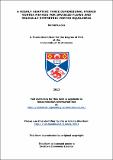Files in this item
A highly adaptive three dimensional hybrid vortex method for inviscid flows and helically symmetric vortex equilibria
Item metadata
| dc.contributor.advisor | Dritschel, David Gerard | |
| dc.contributor.author | Lucas, Daniel | |
| dc.coverage.spatial | 192 | en_US |
| dc.date.accessioned | 2012-09-20T20:24:51Z | |
| dc.date.available | 2012-09-20T20:24:51Z | |
| dc.date.issued | 2012-06-22 | |
| dc.identifier | uk.bl.ethos.556399 | |
| dc.identifier.uri | https://hdl.handle.net/10023/3091 | |
| dc.description.abstract | This thesis is concerned with three-dimensional vortex dynamics, in particular the modelling of vortex structures in an inviscid context. We are motivated by the open problem of regularity of the inviscid equations, i.e. whether or not these equations possess solutions. This problem is manifest in small scales, where vortex filaments are stretched and intensify as they are drawn into increasingly thin tendrils. This creates great difficulty in the investigation of such flows. Our only means of experimentation is to perform numerical simulations, which require exceptionally high resolution to capture the small scale vortex structures. A new numerical method to solve the inviscid Euler equations for three-dimensional, incompressible fluids is presented, with special emphasis on spatial adaptivity to resolve as broad a range of scales as possible in a completely self-similar fashion. We present a hybrid vortex method whereby we discretise the vorticity in Lagrangian filaments and perform and inversion to compute velocity on an arbitrary unstructured finite-volume grid. This allows for a two-fold adaptivity strategy. First, although naturally spatially adaptive by definition, the vorticity filaments undergo ‘renoding’. We redistribute nodes along the filament to concentrate their density in regions of high curvature. Secondly the Eulerian mesh is adapted to follow high strain by increasing resolution based on local filament dimensions. These features allow vortex stretching and folding to be resolved in a completely automatic and self-similar way. The method is validated via well known vortex rings and newly discovered helical vortex equilibria are also used to test the method. We begin by presenting this new class of three-dimensional vortex equilibria which possess helical symmetry. Such vortices are observed in propeller and wind turbine wakes, and their equilibria shapes have until now been unknown. These vortices are described by contours bounding regions of uniform axial vorticity. Material conservation of axial vorticity enables equilibria to be calculated simply by a restriction on the helical stream function. The states are parameterised by their mean radius and centroid position. In the case of a single vortex, the parameter space cannot be fully filled by our numerical approach. We conjecture that multiply connected contours will characterise equilibria where the algorithm fails. We also consider multiple vortices, evenly azimuthally spaced about the origin. In such cases instabilities often lead to a single helical vortex. | en_US |
| dc.language.iso | en | en_US |
| dc.publisher | University of St Andrews | |
| dc.relation | A family of helically symmetric vortex equilibria. Journal of Fluid Mechanics, 634, 2009. | en_US |
| dc.rights | Creative Commons Attribution-ShareAlike 3.0 Unported | |
| dc.rights.uri | http://creativecommons.org/licenses/by-sa/3.0/ | |
| dc.subject | Fluid mechanics | en_US |
| dc.subject | Vortex dynamics | en_US |
| dc.subject | Vortex methods | en_US |
| dc.subject | Turbulence | en_US |
| dc.subject.lcc | QA925.L8 | |
| dc.subject.lcsh | Vortex-motion--Mathematical models | en_US |
| dc.subject.lcsh | Inviscid flow | en_US |
| dc.subject.lcsh | Turbulence | en_US |
| dc.title | A highly adaptive three dimensional hybrid vortex method for inviscid flows and helically symmetric vortex equilibria | en_US |
| dc.type | Thesis | en_US |
| dc.contributor.sponsor | C. K. Marr Educational Trust | en_US |
| dc.type.qualificationlevel | Doctoral | en_US |
| dc.type.qualificationname | PhD Doctor of Philosophy | en_US |
| dc.publisher.institution | The University of St Andrews | en_US |
This item appears in the following Collection(s)
Except where otherwise noted within the work, this item's licence for re-use is described as Creative Commons Attribution-ShareAlike 3.0 Unported
Items in the St Andrews Research Repository are protected by copyright, with all rights reserved, unless otherwise indicated.


